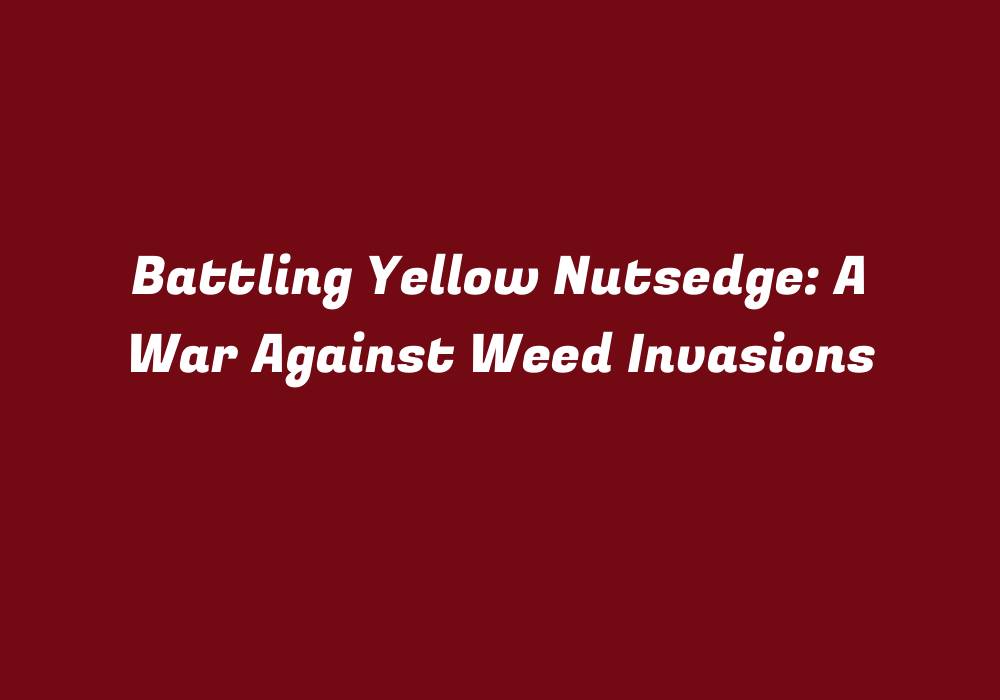Introduction
Yellow Nutsedge, a persistent weed, has been causing significant trouble for gardeners and farmers worldwide. In this article, we delve into the challenges presented by this invasive species and explore potential solutions to combat its spread.
Understanding Yellow Nutsedge
Identification of the Enemy
Yellow Nutsedge (Cyperus esculentus), also known as watergrass, is a common and highly invasive weed. It primarily grows in areas with wet soil conditions, such as lawns, gardens, and agricultural fields.
Characterized by its distinctive yellowish color, stiff leaves, and triangular stems, Yellow Nutsedge can grow up to three feet tall. Its ability to thrive under various conditions makes it a formidable challenge for those seeking to control weed infestations.
Impact on Agriculture and Gardening
Agricultural Challenges
Yellow Nutsedge poses several threats to the agricultural sector. Its presence can lead to reduced crop yield, as it competes for resources such as water, nutrients, and space with crops. It also negatively affects soil structure and fertility, which can further exacerbate challenges faced by farmers.
Moreover, Yellow Nutsedge is known to host various diseases and pests, making it a potential vector for the spread of agricultural pathogens. Controlling this weed can therefore help protect crops from other harmful organisms while promoting better plant health.
Landscaping Issues
In landscaped areas such as lawns, gardens, and parks, Yellow Nutsedge can have a negative aesthetic impact. Its distinctive appearance makes it an eyesore for homeowners, garden enthusiasts, and others who value their outdoor spaces.
Furthermore, the weed’s tendency to thrive in wet soil conditions can cause damage to turf and other plants by reducing oxygen levels in the soil. By controlling Yellow Nutsedge, landowners can help maintain a healthy and visually appealing landscape.
Controlling Yellow Nutsedge: A Multifaceted Approach
Cultural Control
The first step in tackling Yellow Nutsedge is to implement proper cultural control measures. This involves adjusting the growing environment to minimize the weed’s chances of survival and reproduction.
- Maintain a healthy lawn: Regular mowing, proper watering, and fertilization can help promote the growth of desirable grasses while making it difficult for weeds like Yellow Nutsedge to establish themselves.
- Manage soil moisture: Ensure that your lawn is not overwatered or prone to flooding. This can help prevent the establishment of Yellow Nutsedge, as it thrives in wet conditions.
- Monitor and remove seedlings early: Identify and eliminate young Yellow Nutsedge plants before they mature and spread their seeds. By doing so, you will be reducing the overall infestation and making it easier to manage later on.
Mechanical Control Methods
Mechanical control involves using various tools or techniques to physically remove weeds from the landscape. This approach can be particularly effective in smaller areas with limited infestations of Yellow Nutsedge.
- Hand pulling: For individual plants, carefully pull the weed out by the roots. Be sure to get as much root material as possible to prevent regrowth.
- Mowing: Mow your lawn frequently to prevent seed production and discourage Yellow Nutsedge growth. Cutting grass at a height of 2-3 inches is recommended, as this helps promote healthy turfgrass growth while making it difficult for weeds to establish themselves.
- Weed wacker: A weed wacker can help eliminate small clumps of Yellow Nutsedge before they become established. Be careful not to damage desired plants or grasses when using this method.
Chemical Control Options
In some cases, chemical control may be necessary for effectively managing larger infestations of Yellow Nutsedge. However, it is essential to use these methods judiciously and follow label instructions carefully to minimize environmental impact and promote overall plant health.
- Pre-emergence herbicides: Apply a pre-emergence herbicide in spring before the weed seeds begin germinating. This method can be useful for preventing Yellow Nutsedge establishment on larger properties where cultural and mechanical control methods may not suffice.
- Post-emergence herbicides: For established infestations, post-emergence herbicides are often necessary to control the weed’s growth. These products should be applied according to label instructions to minimize negative impacts on surrounding vegetation and promote overall plant health.
- Selective herbicides: Opt for selective herbicides that target specific types of weeds, while minimizing damage to desired plants such as grasses or flowers. This approach can help maintain a healthy balance in your landscape while managing Yellow Nutsedge populations.
Conclusion
A Battle Worth Fighting
Battling Yellow Nutsedge is a multifaceted challenge that requires a comprehensive approach to ensure its successful management in both agricultural and landscaping applications. By understanding the weed’s impact on your garden or farm and implementing proper cultural, mechanical, and chemical control techniques, you can work towards achieving a healthy, vibrant landscape with minimal Yellow Nutsedge infestation.
Tackling this invasive species will not only protect your plants but also promote a thriving ecosystem for years to come. Embrace the fight against weeds like Yellow Nutsedge and strive for a greener, more enjoyable environment where nature can flourish.
